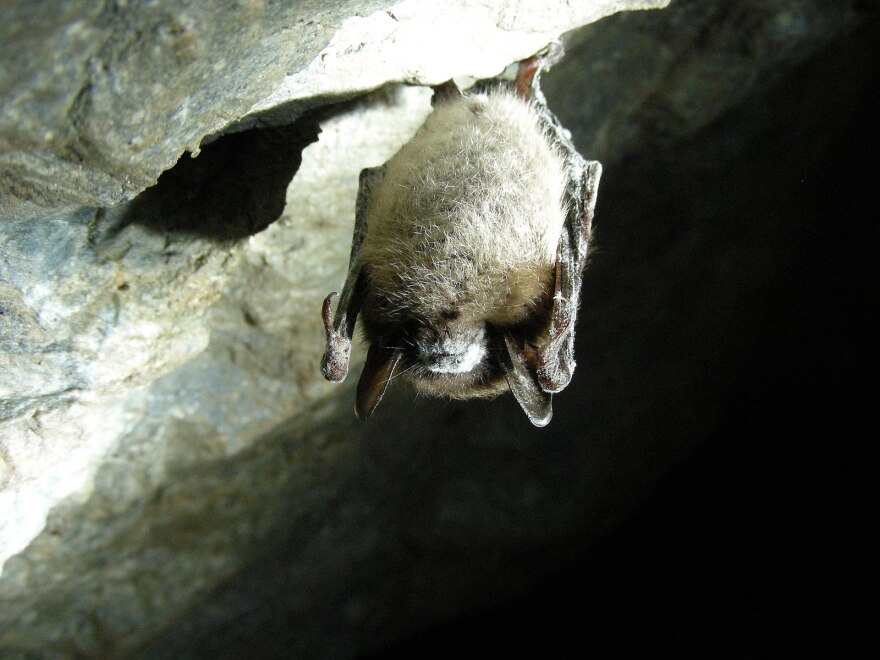“It’s one of the worst things I’ve every seen.” That was the reaction of Nate Fuller, a Texas Tech post-doctoral researcher in biological sciences, when he saw at least 10,000 dead hibernating bats on a cave floor years ago. All died from white nose syndrome, a disease that has decimated more than 5.5 million bats across North America.
To date, the disease, which is caused by a fungus first discovered in the US in 2006 in a New York cave, has been found in 32 US states and seven Canadian provinces. The fungus but not yet the disease, has been detected in Mississippi and in Texas. It now is in eight West Texas counties and two in the Hill Country.
“What white nose syndrome is, is fungus gets on the bat and starts to grow and then as it starts to grow, it goes into the skin and starts to erode away skin layers and causes lesions that grow across mostly skin surfaces, so wings, ears, muzzle,” he says. What the syndrome is, is an expression of these lesions, along with sort of complex cascade of physiological changes that we think are attached to these lesions that are growing on the skin that eventually lead to premature consumption of the fat stores the bats use to hibernate and then they eventually die.”

The loss of so many bats could have a cascading effect on agriculture. In Texas alone bats devour as many as a thousand tons of crop pests every night.
The fungus was first found while surveys of hibernating bats were being done in the New York cave. It isn’t new to science and likes cold and humid places. After identifying the fungus in North America, researchers found it exists also in Old World places, like Europe and Asia.
Fuller’s bat research colleague, assistant professor Liam McGuire, says it is almost certain that the fungus was introduced to North America by humans. Someone may have been in bat caves in Europe, gotten some of the fungus on their shoes and then walked inside the New York cave.
“This is a completely new pathogen to bats in North America, they don’t know how to deal with it, whereas the bats in Europe and Asia have evolved with this fungus for many, many, many years,” he explains.
It’s likely that the bats, which get the fuzzy white fungus on their noses, wings, ears and tails, suffer as they die of either starvation or thirst. The mortality rate in some locations has been 100 percent.
Normally, every couple of weeks hibernating bats go in and out of torpor, a state of reduced body temperature and metabolic rate. McGuire says it’s the frequency of coming out of torpor that drains bats’ fat reserves.

“What happens with white nose syndrome is, the bats start to arose more and more frequently to the point, towards the end of hibernating they may be arising daily instead of every two weeks. And so every one of those arousals cost them a huge amount of fat,” he says. “So they burn through the fat stores too soon.”
Researchers across North America are working to try to deal with the fungus and the disease. One method, Fuller says, is to treat caves and mines where bats hibernate with a fog containing volatile organic compounds given off from the bacteria that’s used to delay the ripening of fruit.
“Figuring out a way to actually effectively treat the whole population is one of the biggest challenges. We have these compounds that can kill the fungus in various ways, but finding a way to administer it in a way that’s effective, that won’t destroy the cave ecosystem, won’t kill the bat and will actually be effective is one of the biggest questions that we have.”
Fuller and McGuire work is funded by a four-year, $700,000 grant from the Department of Defense, which manages a huge amount of federal land. Part of the department’s obligation is to manage natural resources, including wildlife.
McGuire says he remains optimistic despite the disease bringing the most rapid decline ever of any mammal species in North America. “It’s disturbing but you’ve got to get on with it and do the best you can to figure out what we can do about it,” he says. “You’ve got to be optimistic and you’ve got to be hopeful.”



